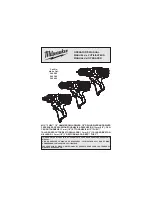
6
english
(original instructions)
7
english
(original instructions)
absolutely necessary.
Use of improper extension
cord could result in risk of fire, electric shock, or
electrocution.
• an extension cord must have adequate wire size
(aWg or american Wire gauge) for safety.
The
smaller the gauge number of the wire, the greater
the capacity of the cable, that is 16 gauge has more
capacity than 18 gauge. When using more than one
extension to make up the total length, be sure each
individual extension contains at least the minimum wire
size.
• do not operate charger with damaged cord or
plug —
have them replaced immediately.
• do not operate charger if it has received a sharp
blow, been dropped, or otherwise damaged in
any way.
Take it to an authorized service center.
• do not disassemble charger;
take it to an
authorized service center when service or repair is
required. Incorrect reassembly may result in a risk of
electric shock, electrocution or fire.
• disconnect the charger from the outlet before
attempting any cleaning.
This will reduce the risk
of electric shock. Removing the battery pack will not
reduce this risk.
• never attempt to connect 2 chargers together.
• the charger is designed to operate on standard
household electrical power (120 volts). do not
attempt to use it on any other voltage.
save these instructions
imPortant safety instruction for
battery Packs
Warning:
For safe operation, read this manual and
manuals originally supplied with tool before using the charger.
The battery pack is not fully charged out of the carton.
Before using the battery pack and charger, read
the safety instructions below. Then follow charging
procedures outlined.
read all instructions
• do not incinerate the battery pack even if it is
severely damaged or is completely worn out.
The
battery pack can explode in a fire. Toxic fumes and
materials are created when battery packs are burned.
• do not charge or use battery in explosive
atmospheres, such as in the presence of flammable
liquids, gases or dust.
Inserting or removing the
battery from the charger may ignite the dust or fumes.
• if battery contents come into contact with the skin,
immediately wash area with mild soap and water.
If battery liquid gets into the eye, rinse water over the
open eye for 15 minutes or until irritation ceases. If
medical attention is needed, the battery electrolyte for
Lithium-Ion batteries is composed of a mixture of liquid
organic carbonates and lithium salts.
• contents of opened battery cells may cause
respiratory irritation.
Provide fresh air. If symptoms
persist, seek medical attention.
Warning: burn hazard.
Battery liquid may be
flammable if exposed to spark or flame.
• Charge the battery packs only in black + decker
chargers.
• do not splash or immerse in water or other
liquids.
This may cause premature cell failure.
• do not store or use the tool and battery pack in
locations where the temperature may reach or
exceed 105°F (40˚C) (such as outside sheds or
metal buildings in summer).
Warning:
Never attempt to open the battery pack
for any reason. If battery pack case is cracked or
damaged, do not insert into charger. Do not crush, drop
or damage battery pack. Do not use a battery pack or
charger that has received a sharp blow, been dropped,
run over or damaged in any way (i.e., pierced with a nail,
hit with a hammer, stepped on). Damaged battery packs
should be returned to service center for recycling.
Warning: fire hazard. do not store or carry battery
so that metal objects can contact exposed battery
terminals.
For example, do not place battery in aprons,
pockets, tool boxes, product kit boxes, drawers, etc., with
loose nails, screws, keys, etc.
transporting batteries can
possibly cause fires if the battery terminals inadvertently
come in contact with conductive materials such as keys,
coins, hand tools and the like.
The US Department of
Transportation Hazardous Material Regulations (HMR)
actually prohibit transporting batteries in commerce or on
airplanes (i.e., packed in suitcases and carry-on luggage)
UNLESS they are properly protected from short circuits. So
when transporting individual batteries, make sure that the
battery terminals are protected and well insulated from
materials that could contact them and cause a short circuit.
note: lithium-ion batteries should not be put in checked
baggage.
storage recommendations
1. The best storage place is one that is cool and dry
away from direct sunlight and excess heat or cold.
2. Long storage will not harm the battery pack or
charger.
charging Procedure
black + decker
chargers are designed to charge
black + decker
battery packs in 3-5 hours depending
on the pack being charged.
1. Plug the charger into an appropriate outlet before
inserting the battery pack.
2. Insert the battery pack into the charger as shown in
figure a.
3. The green LED will flash indicating that the battery
is being charged.
4. The completion of charge is indicated by the green
LED remaining on continuously. The pack is fully
charged and may be used at this time or left on the
charger.
Recharge discharged batteries as soon
as possible after use or battery life may
be greatly diminished. For longest battery
Содержание AUTO01
Страница 2: ...2 1 2 3 5 7 4 8 9 6 B A ...
Страница 3: ...3 D F C E G 1 2 4 7 3 9 8 ...
Страница 32: ...90608672 03 2014 ...








































